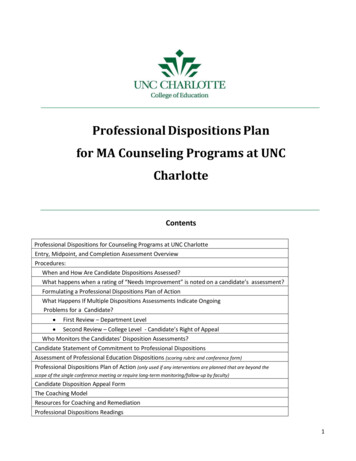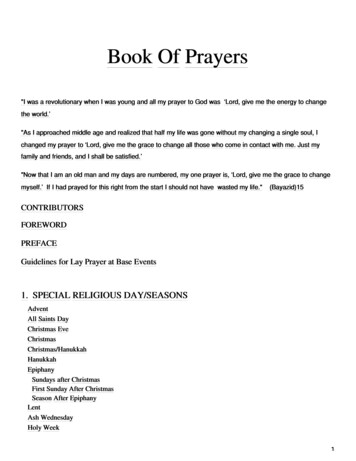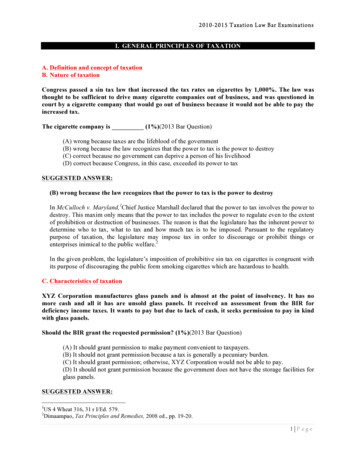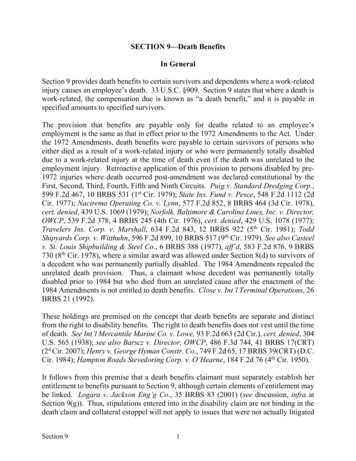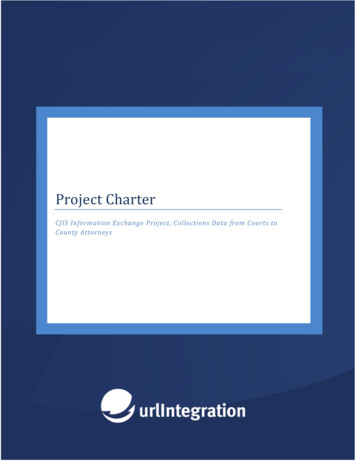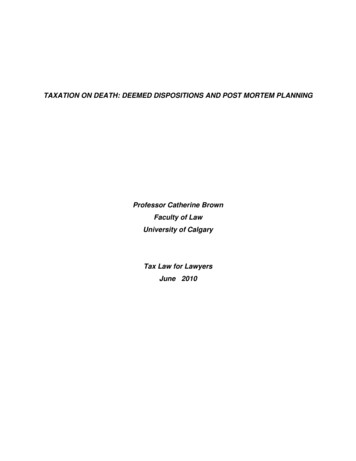
Transcription
TAXATION ON DEATH: DEEMED DISPOSITIONS AND POST MORTEM PLANNINGProfessor Catherine BrownFaculty of LawUniversity of CalgaryTax Law for LawyersJune 2010
iTABLE OF CONTENTSINTRODUCTION . 1I.II.INCOME . 21.PERIODIC PAYMENTS . 22.RIGHTS OR THINGS . 3PROPERTY . 51.CAPITAL PROPERTY . 5A.B.C.General . 5i.Fair Market Value . 6ii.Property Owned by the Deceased. 8iii.Transfers as a Consequence of Death . 9Relieving Provisions for Capital Property . 9i.Property Transferred to, or in Trust, for a Spouse orCommon-Law Partner . 10a.To a Spouse or Common-Law Partner . 10Vested Indefeasibly . 12i.To a Trust for a Spouse or Common-Law Partner (ConjugalTrust) . 13ii.Entitled to All of the Income . 14iii.Transfers as a Consequence of Death . 16iv.Tainted Trusts . 17v.Residence of Trusts . 20a.Transfers of Farm Property . 21b.Principal Residence . 242.LAND INVENTORY . 253.RESOURCE PROPERTIES . 264.ELIGIBLE CAPITAL PROPERTY . 265.PARTNERSHIP RIGHTS . 27A.B.Death of an Active Partner. 28Death of a Retired Partner . 306.LIFE ESTATES . 337.TAXABLE CANADIAN PROPERTY . 34
iiIII.8.PROCEEDS OF LIFE INSURANCE . 359.OTHER PROPERTY OF THE DECEASED . 36DEDUCTIONS, CREDITS AND EXEMPTIONS . 411.DEDUCTIONS . 41A.B.From Income . 42i.Reserves . 42ii.Capital Gains Deduction . 43iii.Capital Losses . 46Computation of Tax . 47i.Charitable Donations . 47ii.Medical Expenses . 502.ALTERNATIVE MINIMUM TAX . 513.OTHER SEPARATE RETURNS . 52APPENDIX 1 . 54Post Mortem Planning . 54
1INTRODUCTIONTwo things in life are certain, death and taxes. This paper examines tax liability on death,filing and reporting obligations and options to reduce or avoid tax costs.The deceased’s personal representative has the responsibility of settling the deceased'saccount with the Canada Revenue Agency (the CRA). A return must be filed for the year ofdeath (the terminal year) and any tax outstanding with respect to that year or earlier yearsmust be paid. As the amount of tax due can vary depending on the terms of the will (orrelevant intestacy legislation) and the decisions made by the personal representative, thusunderstanding and planning for income tax liability in the year of death and throughout theadministration of the estate is important.In general there are three categories of special rules that apply to taxation on death. First,the rules for computing income for the terminal year vary in a number of important respectsfrom those that apply during a taxpayer's lifetime. The most significant of these provide thepersonal representative with a number of options or elections. Others deem certain typesof property to have been disposed of by the deceased immediately prior to his/her death inreturn for proceeds generally equal to the fair market value of the property. In addition,rules throughout the Act1 provide special treatment with respect to reserves, the use ofcapital losses and other deductions and credits in the year of death. Second, a number ofprovisions provide special tax treatment for specific types of income and property. Theseinclude provisions regulating rights to income that is still accruing at the date of the death,other payments that could have been demanded during the lifetime of the deceased (rightsand things), capital property, eligible capital property, resource properties and land that isinventory of a business. Finally, there are a number of provisions that allow for the filing ofseparate returns.1thAll references to the "Act" and section references are to the Income Tax Act, R.S.C. 1985, c. 1 (5 Supp.), asamended, unless otherwise noted.
2I.INCOME1.PERIODIC PAYMENTSIn computing the income of a taxpayer for the year of death, amounts that would havebeen income for that year, if the taxpayer had lived, must be included. A common exampleis accrued bank interest. As well, there may be certain amounts that, although not accruedduring the taxpayer's lifetime, will be deemed to be income for the terminal year.Subsection 70(1) provides that, income that is payable periodically, but that is still accruingat the date of death, is subject to a notional severance and is deemed to have accrued inequal amounts from day to day. The amount deemed to have accrued up to and includingthe day of death is included in income for the terminal year 2. The remaining incomebelongs to the estate, which is treated as a separate taxpayer under the Act. Examples ofperiodic payment include amounts that represent accrued but unpaid wages or salaries,interest from bonds, rents, royalties and/or annuity payments.The inclusion of these periodic payments in income in the year of death is obligatory andthere are no special options or elections if income amounts fall within subsection 70(1).As this may not be the case with respect to other income amounts, such as rights or things(discussed below), the scope of the provision is of some importance. The CRA’s positionwith respect to what constitutes a periodic payment is outlined in Interpretation Bulletin210R2, and can be summarized as follows. Section 70(1) does not apply to amounts thatwere payable before death, but rather applies to an amount payable on a periodic basisthat was not paid to a taxpayer before their death. For example, assume a deceasedtaxpayer owned a term deposit and interest was payable periodically on an annual basis atstcalendar year end, the portion accruing from January 1 up to and including the date ofdeath would be included in the terminal return. Also included is any salary or wagesaccrued from the beginning of the pay period in which an employee dies to the date ofdeath. Any accrued expenses relating to an amount included in income under subsection2Payments of a periodic nature received by the deceased taxpayer on the actual date of his death wereheld to fall within the purview of subsection 70(1) per Estate of R. Fontaine v. The Queen, 95 DTC 5580.
370(1) can be deducted, for example, interest expense on borrowed monies.2.RIGHTS OR THINGSCertain payments that the taxpayer could have demanded during their lifetime areclassified as rights and things and are taxed as per subsection 70(2). Any income fallingwithin subsection 70(1) is excluded from subsection 70(2). Examples of rights or thingsinclude declared but unpaid dividends, declared but unpaid bonuses, deferred cashpurchase tickets and un-cashed matured bond coupons. Furthermore, retroactive salaryand wage adjustments are considered rights and things. However, where an employer hasa contractual obligation to pay an annual bonus or some other periodic bonus, but thebonus is not declared at the time of death, the amount is treated as a periodic paymentand included in income under subsection 70(1)3. As the distinction between periodicpayments and rights and things can be unclear, the CRA’s policy is to resolve any disputesabout the genuine nature of the income in favor of the taxpayer. Note that capital property,eligible capital property, land included in the inventory of a business, resource propertiesand interests in life insurance policies are excluded from the definition of rights or things.The main difference between rights or things (subsection 70(2)) and periodic payments(subsection 70(1)), is that periodic payments could not have been demanded by thedeceased during their lifetime. Thus, if the amount was due or payable before death it willnot fall within subsection 70(1). If it was not due before death it will fall within subsection70(1) only if, as well, it is an amount payable on a periodic basis. In summary if the amountwas not payable periodically or it was due before death, it may be a right or thing.Subsections 70(1) and (2) are obviously tidying-up provisions designed to tax unrealizedamounts that would have been included in the deceased's income for the year or for asubsequent year if he or she had lived. Of the two provisions, subsection 70(2) is the more3CRA Views, Ruling 2006-0168181E5. May 31, 2006. In Tory Estate v. MNR, [1973] C.T.C. 434, it washeld that accounts receivable of a business reporting its income on a cash basis were rights and things.
4attractive from the taxpayer's viewpoint. If applicable, the deceased's personalrepresentative may:i.file a separate return for rights or things;ii.transfer rights or things to a beneficiary under subsection 70(3); oriii.include the net value of rights or things in the terminal return.If the personal representative does not choose either the first or second alternative withinone year of the deceased's death, or 90 days from the mailing of a notice of assessment,the third alternative becomes mandatory.If the personal representative elects under subsection 70(2) to file a separate return forrights or things, tax will be levied as if the deceased were another person. This isadvantageous as another set of personal credits (basic credit, spouse or common-lawpartner credit, age credit, etc) can be claimed to reduce the overall tax liability. In addition,the alternative minimum tax provisions will not apply.If the option of transferring rights or things to a beneficiary is chosen as per subsection70(3), income is not realized until the beneficiary disposes of the right or thing. When sucha disposition occurs, the amount received on disposition, minus the cost of the right orthing, is included in the beneficiary’s income. The new cost to the beneficiary is deemed tobe the cost to the deceased plus any costs incurred in acquiring the property from theestate.Subsection 70(3) applies to rights or things transferred to a beneficiary notwithstanding thatother rights or things are retained in the estate. In the CRA’s view, it is not possible to file aseparate return for some rights or things but include others in the deceased's terminalreturn. If an election to file a separate return is made, it will, according to the CRA, cover allrights or things that were not transferred to a beneficiary within the year.
5II.PROPERTY1.CAPITAL PROPERTYA.GeneralThe policy of realizing all future income of the deceased also applies to unrealized taxablecapital gains. Subsection 70(5) deems all capital property owned by the taxpayerimmediately prior to his or her death to have been disposed of at that time in return forproceeds equal to fair market value. It follows that there may be a capital gain or capitalloss, and in the case of depreciable property, a recapture of capital cost allowance or aterminal loss. The deceased's personal representative will normally acquire the property ata cost corresponding to the proceeds of disposition.If the property is depreciable property of a prescribed class, a further adjustment isrequired if the fair market value of the property immediately prior to death is less than thecapital cost of the property to the deceased. In that case, the beneficiary is deemed byparagraph 70(5)(c) to have acquired the property at a capital cost equal to that of thedeceased and the excess of the deceased's capital cost over the deemed proceeds ofdisposition is treated as if it had been claimed by the beneficiary as capital cost allowancein previous years.4Capital gains that arise by virtue of a deemed disposition under subsection 70(5) mayqualify for the 750,0005 capital gains deduction, for dispositions of qualifying property.Qualifying property includes qualified farm property, qualified fishing property (2006amendment), and shares of a qualified small business corporation. In addition, if thedeceased's capital property is transferred to a trust for a spouse or common-law partner(conjugal trust), under subsection 70(6), the conjugal trust is entitled to claim a capitalgains deduction for the taxation year in which the deceased's spouse or common-law4A number of other adjustments may also be required under paragraph 70(5) for certain depreciable assetssuch as buildings. See generally paragraph 70(5)(a) and subsection 13(21.2).
6partner died, to the extent that the spouse or common-law partner would have been able toclaim an exemption if the eligible capital gains of the trust had been realized by thedeceased's spouse or common-law partner directly [paragraph 110.6(12)(c)].There are three issues that generally arise around the operation of the deemed dispositionrules in subsection 70(5).1.What is fair market value at death and, in particular, what factors affect fair marketvalue?2.What assets are considered “owned” by a taxpayer immediately prior to death forpurposes of subsection 70(5)?3.When and under what circumstances will property be viewed for purposes of therelieving provisions in subsection 70(6) as being transferred or distributed as aconsequence of death?i.Fair Market ValueSubsection 70(5) deems capital property of a deceased person to be disposed ofimmediately before death for proceeds equal to fair market value at that time. In somecases the "value" of the deceased's property will be affected by the fact of death. Forexample, the deceased may have been a shareholder and the "key man" of anincorporated business. On death, his or her shares are deemed to have been disposed ofat fair market value. Of ongoing concern to estate planners is whether transactionsinvolving the corporation that occur either as a result of the death or shortly thereaftershould be considered in the valuation of the corporation's net assets and, thus, thedeceased's shares. This issue was addressed in Mastronardi Estate v. R.656Increased from 500,000 on March 18, 2007.[1976] C.T.C. 572, 76 D.T.C. 6306 (F.C.T.D.).
7In Mastronardi, the deceased died suddenly and without warning. His private company wasthe beneficiary of a 500,000 life insurance policy on his life. The issue before the FederalCourt was whether the life insurance proceeds should be included, for purposes ofsubsection 70(5), in valuing the shares of the company held by the deceased.The court held that it wasn’t until the instant of death that the company became entitled tothe proceeds of the life insurance policy. Since the words “immediately before death” insubsection 70(5) refer to a span of time before death, the words could not be construed toimport a requirement that capital property be valued taking into account the imminence ofdeath. It follows that the value of the life insurance policy should not be included in thedetermining fair market value of the shares.Any victory won by the taxpayer in the Mastronardi decision was short lived. Subsection70(5.3) now provides that in valuing shares held by the deceased, the cash surrendervalue of any life insurance policies held by the corporation on the life of the deceased mustbe considered. The logic underlying this requirement would appear to be that thecorporation could liquidate the policy for its cash surrender value immediately prior to thedeath. For more information, see Information Circular 89-3, August 25, 1989, “PolicyStatement on Business Equity Valuations”.This valuation rule was expanded in 2001 to apply when determining the fair market valueof any property owned by the taxpayer immediately prior to death including an interest in atrust or partnership. It was also expanded to include life insurance policies held on the lifeof a related person and to the deemed disposition of trust assets under subsection 104(4).Notwithstanding the introduction of subsection 70(5.3), the decision in Mastronardiremains important for its discussion of the point in time at which a disposition undersubsection 70(5) occurs and the factors a court may consider in determining fair marketvalue at that time. For example, if death was imminent due to a prolonged illness, that factmay be relevant in determining fair market value of property at death.
8Valuation problems may also occur if the shares are subject to a buy-sell agreement.Specifically, the pre-determined purchase price selected by the parties may not reflectcurrent market values. The problem that may arise, if the agreed price is used to determineproceeds for purposes of the buy-sell agreement, is that the amount so selected, may notequal fair market value for purposes of subsection 70(5). The CRA’s views in resolving thisissue are summarized as follows. The price in a buy-sell agreement between arm’s lengthparties is generally accepted. However, where the deceased and the surviving party to abuy-sell agreement did not deal at arm’s length, it is a question of fact whether the fairmarket value for the purpose of subsection 70(5) will be determined with reference to theagreement. Paragraph 69(1)(b) may apply to change the stated value of the buy-sellagreement to reflect fair market value in a non-arm’s length transaction and the deceasedmay be deemed for tax purposes to have received a different amount than actuallyreceived. For further details, see Interpretation Bulletin 140-R3, April 14, 1989, “Buy-sellAgreements”.ii.Property Owned by the DeceasedSince the provisions in subsection 70(5) apply to any capital property owned by thedeceased immediately prior to death, a careful review of the deceased’s assets will benecessary. Consider the effect of subsection 70(5) in relation to property jointly owned bythe deceased, and property held as a life estate.7 Such property rights are also subject tothe deemed disposition rules. For example, the deceased’s interest in a house held jointlywith his or her spouse is subject to a deemed disposition on death under subsection 70(5)notwithstanding that the house automatically transfers to the spouse by operation of law.In the CRA’s view the joint tenancy could have been severed immediately prior to death.The disposition is therefore of a notional interest held by a tenant in common. If the houseis a principal residence, the gain may qualify for the principle residence exemption detailedbelow.7Paragraph 43.1(2)(a).
9iii.Transfers as a Consequence of DeathAs discussed below, relief from the deemed disposition provisions in subsection 70(5) isprovided to the deceased if property is transferred to a spouse, common-law partner, orconjugal trust, as well as to children in the case of qualified farm or fishing property. Thisrelief is predicated by the requirement that the property be transferred to the intendedbeneficiary in accordance with subsection 248(8). In summary, this provision requires thatthe property be transferred by will or other testamentary instrument, on intestacy or as theresult of a disclaimer, or release or surrender. Subsection 248(8) is discussed in moredetail below.B.Relieving Provisions for Capital PropertyThe deemed disposition rules applicable on death may give rise to tax liability. If theproperty continues to be used by the deceased's family, the tax liability is made moreonerous if the estate does not have sufficient liquidity to discharge that liability without saleof the property. Fortunately, the Act contains a number of relieving provisions (rollovers)with respect to capital property, which apply if the property is transferred either to thespouse or common-law partner of the deceased, to a trust for the benefit of either, or inlimited circumstances to the deceased’s children as a consequence of death.Where a rollover applies, the deceased is deemed to have disposed of his or her nondepreciable capital property immediately prior to death for proceeds of disposition equal tothe adjusted cost base of the property and, in the case of depreciable property, forproceeds equal to its undepreciated capital cost. As a result, the deceased will not suffercapital gains or recapture by virtue of subsection 70(5). However, any tax liability thatwould otherwise have arisen is not forgiven; it is merely deferred until the transfereesubsequently disposes of the property. Each of these relieving provisions is discussedbelow.The Act provides for a rollover of both depreciable and non-depreciable capital propertytransferred to the deceased's spouse or common-law partner or to a trust for either. There
10are additional rollovers for farm or fishing property, shares of a family farm corporation, orinterest in a family farm or fishing partnership or corporation transferred to the deceased'sspouse, common-law partner, a trust for either, or to children of the deceased.i.Property Transferred to, or in Trust, for a Spouse or Common-Law Partnera.To a Spouse or Common-Law PartnerCapital property transferred to a deceased's spouse or common-law partner as aconsequence of death is not subject to the deeming provisions in subsection 70(5) if thefollowing conditions are met:the deceased and his or her spouse or common-law partner are resident inCanada immediately before the death of the deceased 8; andthe property vests indefeasibly in the spouse or common-law partner within36 months of the deceased's death and the fact of this vesting is establishedwithin 36 months of the death or such longer period as the Ministerdetermines reasonable in the circumstances upon written application for anyextension made within the period.If these conditions are met, the property is automatically deemed by subsection 70(6) to rollto the beneficiary at its tax cost unless the personal representative elects under subsection70(6.2) to have the deemed disposition in subsection 70(5) apply. Such an election mightbe made, for example, to create capital losses or terminal losses in the deceased’sterminal year or to maximize otherwise available capital losses against current capitalgains.There are four ways in which property can be rolled "as a consequence of death" to a8The Third Protocol to the Canada-U.S. Tax Treaty permits a rollover to a spouse or common-law partnerwhere the deceased was resident in the U.S. immediately before death.
11spouse or common-law partner:1. by will or other testamentary instrument [paragraph 248(8)(a)];2. on an intestacy [paragraph 248(8)(a)];3. by disclaimer, or release or surrender of a beneficiary under a will or on an intestacy[paragraph 248(8)(b)]; and4. as a consequence of provincial laws relating to spouse’s or common-law partner’sinterest in property [subsections 248(9.1) and (23.1)].Proof that vesting has occurred must be established within 36 months of the date of deathor such longer period as the Minister considers reasonable. Therefore, delay in takingsteps to establish vesting may exclude the application of the rollover. Although whatconstitutes a reasonable period should be a question of fact, the Act leaves the matter tobe determined by the Minister if written application is made within 36 months of the death.Presumably a delay in establishing vesting owing to litigation or a settlement of claimswould be considered reasonable. The only real guidance on this question is Hillis et al. v.The Queen,9 which precluded a rollover due to an unreasonable delay in administering anestate. As a result of that decision, the period for establishing vesting was increased from15 to 36 months. Perhaps coincidentally, this closely matches the actual administrationperiod in the Hillis case.The Hillis decision is probably also the reason for the introduction of subsection 248(23.1)that now specifically recognizes the effect of provincial legislation in determining the timingof the transfer to a spouse or common-law partner. A transfer that results from a FamilyRelief application, for example, may be effective as of the date of death. The transfer isdeemed to occur as a consequence of death if made to the spouse or common-law9Hillis et al. v The Queen 83 DTC 5365 (FCA)
12partner, or immediately before the time that is immediately before the death if the transferis made by the spouse or common-law partner to the deceased’s estate. In either case arollover occurs notwithstanding that a provincial court order is made outside the 36 monthperiod.C.Vested IndefeasiblySubsection 70(6) requires that the property "vest indefeasibly" in the spouse or commonlaw partner to achieve a rollover. Subsection 70(9) imposes a similar requirement fortransfers of qualifying farm or fishing property to a child. Not surprisingly, a number ofdecisions have addressed the issue of when property vests indefeasibly for thesepurposes. One of the most important of these decisions is Boger Estate v. MNR10.In Boger, the taxpayer, a farmer, died testate on March 10, 1979. A life estate in the homequarter was left to his widow and the remaining farm assets (seven quarter sections ofland, farm equipment, livestock and grain) were left to his four daughters. The widowbrought a Family Relief Act Application. At issue was whether the farm property vestedindefeasibly in the children within the required time for purposes of the farm rollover insubsection 70(9), notwithstanding the outstanding Family Relief Act application. TheFederal Court held that the property interest was granted under the will and had vested.Further, a vested interest is defeasible only if it is subject to a condition subsequentcontained in the grant creating the interest. The Family Relief Act application did not delayvesting, but a portion of the interest transferred to the children was retroactively affected bythe court order. In summary, according to Boger, the test to determine whether an interestis vested indefeasibly is whether it is “subject to a condition subsequent or a determinablelimitation set out in the grant.”A number of decisions have also examined the issue of vesting in the context ofshareholder agreements. In W.R. Parkes v. MNR11, and Greenwood Estate v. Canada,1210Boger Estate v MNR, [1993] 2 CTC 81 (FCA)11W.R. Parkes v MNR, [1986] 1 CTC 2262
13the court held that shares subject to a mandatory buy-sell agreement did not vestindefeasibly for purposes of the spousal rollover. In contrast, in Van Son Estate v.Canada13, a right of first refusal in an agreement, which imposed an obligation to buy onthe survivor but no obligation to sell on the beneficiary spouse, resulted in a finding that theshares had vested indefeasibly. The CRA’s current position is that shares subject to acompulsory buy-sell agreement will not qualify for subsection 70(6) rollover treatment.However, the CRA will accept shotgun and right of first refusal clauses and allow forrollover treatment in these situations.Certain limitations also apply in determining whether vesting has occurred. For example,paragraph 248(9.2)(a) provides that property will be deemed not to have vestedindefeasibly in a trust where the taxpayer’s spouse or common-law partner is a beneficiaryif the trust is created by the will of the taxpayer, unless the property vested indefeasibly inthe trust before the death of the spouse or common-law partner. The apparent purpose ofthis provision is to ensure that a rollover of property on the death of an individual will occuronly in circumstances where the deferred gains will be recognized on the death of thebeneficiary spouse or common-law partner. Similarly, paragraph 248(9.2)(b) provides thatproperty will be deemed not to have vested indefeasibly in an individual (other than a trust),unless the property vested indefeasibly in the individual before their death.i.To a Trust for a Spouse or Common-
loss, and in the case of depreciable property, a recapture of capital cost allowance or a terminal loss. The deceased's personal representative will normally acquire the property at a cost corresponding to the proceeds of disposition. If the property is depreciable property of a prescribed class, a further adjustment is
